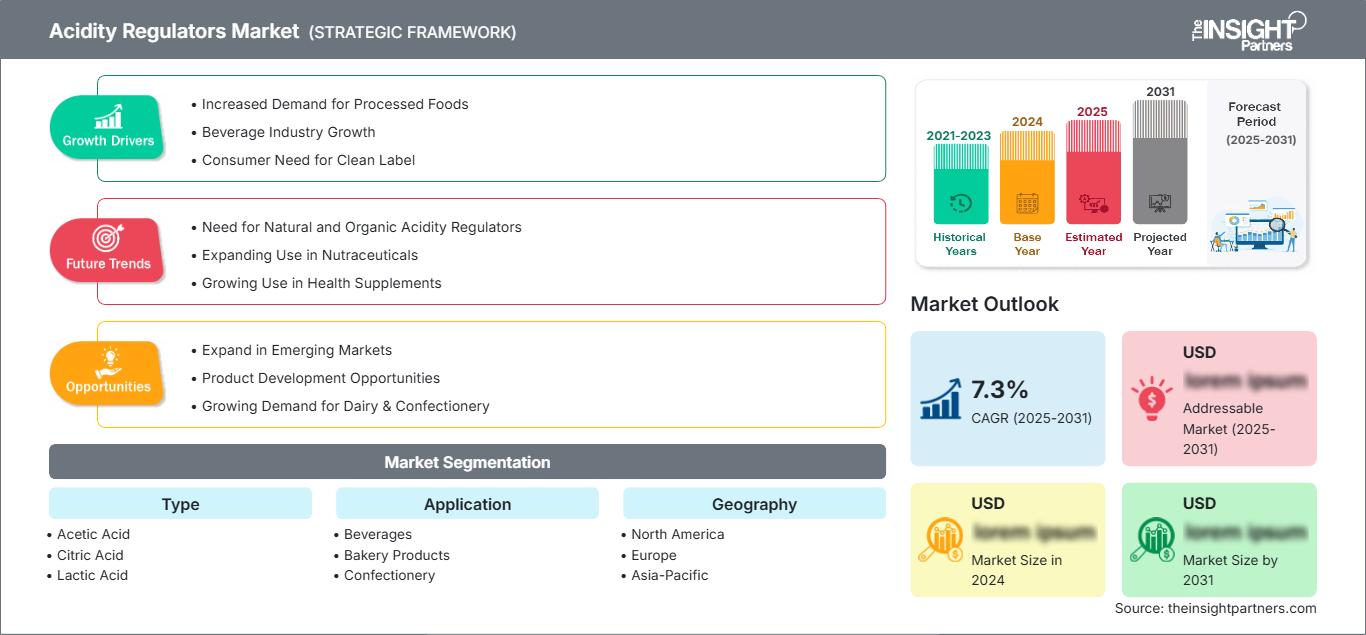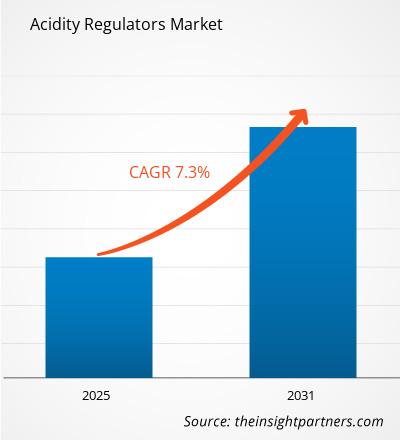Der Markt für Säureregulatoren wird voraussichtlich zwischen 2025 und 2031 eine durchschnittliche jährliche Wachstumsrate (CAGR) von 7,3 % verzeichnen, wobei die Marktgröße von XX Millionen US-Dollar im Jahr 2024 auf XX Millionen US-Dollar im Jahr 2031 anwachsen wird.
Der Markt für Säureregulatoren ist nach Typ in die folgenden Untersegmente unterteilt: Essigsäure, Zitronensäure, Milchsäure, Apfelsäure und Sonstige. Darüber hinaus wird eine Analyse basierend auf der Anwendung präsentiert, d. h. Getränke, Backwaren, Süßwaren, verarbeitete Lebensmittel, Milchprodukte und Sonstige. Die globale Analyse ist auf regionaler Ebene und nach den wichtigsten Ländern aufgeschlüsselt. Die Marktbewertung wird für die obige Segmentanalyse in US-Dollar angegeben.
Zweck des Berichts
Der Bericht „Markt für Säureregulatoren“ von The Insight Partners zielt darauf ab, die aktuelle Situation und das zukünftige Wachstum sowie die wichtigsten treibenden Faktoren, Herausforderungen und Chancen zu beschreiben. Dadurch erhalten verschiedene Geschäftsinteressenten Einblicke, beispielsweise:
- Technologieanbieter/-hersteller: Um die sich entwickelnde Marktdynamik zu verstehen und die potenziellen Wachstumschancen zu kennen, sodass sie fundierte strategische Entscheidungen treffen können.
- Investoren: Um eine umfassende Trendanalyse hinsichtlich der Marktwachstumsrate, der finanziellen Marktprognosen und der Chancen entlang der Wertschöpfungskette durchzuführen.
- Regulierungsbehörden: Um Richtlinien und Überwachungsaktivitäten auf dem Markt zu regulieren, mit dem Ziel, Missbrauch zu minimieren, das Vertrauen der Investoren zu wahren und die Integrität und Stabilität des Marktes aufrechtzuerhalten.
Säureregulatoren Marktsegmentierung Typ
- Essigsäure
- Zitronensäure
- Milchsäure
- Apfelsäure
- Sonstige
Anwendung
- Getränke
- Backwaren
- Süßwaren
- Verarbeitete Lebensmittel
- Milchprodukte
- Sonstige
Sie erhalten kostenlos Anpassungen an jedem Bericht, einschließlich Teilen dieses Berichts oder einer Analyse auf Länderebene, eines Excel-Datenpakets sowie tolle Angebote und Rabatte für Start-ups und Universitäten.
Markt für Säureregulatoren: Strategische Einblicke

-
Holen Sie sich die wichtigsten Markttrends aus diesem Bericht.Dieses KOSTENLOSE Beispiel umfasst Datenanalysen, die von Markttrends bis hin zu Schätzungen und Prognosen reichen.
Wachstumstreiber für Säureregulatoren
- Steigende Nachfrage nach verarbeiteten Lebensmitteln: Da sich die Geschmackspräferenzen der Verbraucher hin zu verarbeiteten und verpackten Lebensmitteln verlagern, wünschen sich die Verbraucher auch mehr Säureregulatoren, um den Geschmack zu verbessern und die Frische und Haltbarkeit zu erhalten.
- Wachstum der Getränkeindustrie: Das Wachstum der Getränkeindustrie – insbesondere von Limonaden und Fruchtsäften – treibt die Nachfrage nach Säureregulatoren zur Aufrechterhaltung des pH-Werts und des Geschmacks an.
- Verbraucherwunsch nach Clean Label: Da der Verbrauchermarkt für Clean Label-Lebensmittel wächst, liegen natürliche Säureregulatoren wie Zitronensäure, deren chemische Zusammensetzung keine synthetischen Stoffe enthält und daher als sicher gilt, im Trend.
Zukünftige Trends im Markt für Säureregulatoren
- Bedarf an natürlichen und organischen Säureregulatoren: Lebensmittelkonsumenten suchen nach verschiedenen natürlichen, organischen, pflanzlichen und naturbasierten Zutaten, was zu einer erhöhten Nachfrage nach organischen Säureregulatoren wie Zitronensäure, Apfelsäure und Weinsäure führt Säure für die Lebensmittel- und Getränkeproduktion.
- Zunehmende Verwendung in Nutrazeutika: Auch Nutrazeutika und funktionellen Lebensmitteln werden Säureregulatoren zugesetzt, um den pH-Wert im richtigen Bereich zu halten und so die Bioverfügbarkeit der Nährstoffe zu erhöhen und so das Marktwachstum zu fördern.
- Zunehmende Verwendung in Nahrungsergänzungsmitteln: Da Verbraucher gesundheitsbewusster werden und mehr funktionelle Lebensmittel und Nahrungsergänzungsmittel bevorzugen, finden Säureregulatoren zunehmend Anwendung in Lebensmitteln wie Nahrungsergänzungsmitteln, Vitamin-C-Formulierungen und Energydrinks.
Marktchancen für Säureregulatoren
- Expansion in Schwellenländern: Der steigende Konsum verarbeiteter Lebensmittel in Schwellenländern (insbesondere Asien und Lateinamerika) birgt das größte Wachstumspotenzial für den Markt für Säureregulatoren.
- Möglichkeiten für die Produktentwicklung: Unternehmen haben die Chance, neue Formen von Säureregulatoren zu entwickeln, die den wachsenden Markt für Clean-Label- und Bio-Lebensmittel bedienen und den Markt besser differenzieren.
- Steigende Nachfrage nach Milchprodukten und Süßwaren: Die wachsende Nachfrage nach Milchprodukten und Süßwaren, insbesondere in aufstrebenden Mittelschichtländern, bietet eine breite Palette an Möglichkeiten, Säureregulatoren zur Geschmacksanpassung und Verbesserung der Produktqualität einzusetzen.
Markt für Säureregulatoren
Die Analysten von The Insight Partners haben die regionalen Trends und Faktoren, die den Markt für Säureregulatoren im Prognosezeitraum beeinflussen, ausführlich erläutert. In diesem Abschnitt werden auch die Marktsegmente und die geografische Lage in Nordamerika, Europa, dem asiatisch-pazifischen Raum, dem Nahen Osten und Afrika sowie Süd- und Mittelamerika erörtert.Umfang des Marktberichts zu Säureregulatoren
| Berichtsattribut | Einzelheiten |
|---|---|
| Marktgröße in 2024 | US$ XX million |
| Marktgröße nach 2031 | US$ XX Million |
| Globale CAGR (2025 - 2031) | 7.3% |
| Historische Daten | 2021-2023 |
| Prognosezeitraum | 2025-2031 |
| Abgedeckte Segmente |
By Typ
|
| Abgedeckte Regionen und Länder |
Nordamerika
|
| Marktführer und wichtige Unternehmensprofile |
|
Dichte der Marktteilnehmer für Säureregulatoren: Verständnis ihrer Auswirkungen auf die Geschäftsdynamik
Der Markt für Säureregulatoren wächst rasant. Die steigende Nachfrage der Endverbraucher ist auf Faktoren wie veränderte Verbraucherpräferenzen, technologische Fortschritte und ein stärkeres Bewusstsein für die Produktvorteile zurückzuführen. Mit der steigenden Nachfrage erweitern Unternehmen ihr Angebot, entwickeln Innovationen, um den Bedürfnissen der Verbraucher gerecht zu werden, und nutzen neue Trends, was das Marktwachstum weiter ankurbelt.
- Holen Sie sich die Markt für Säureregulatoren Übersicht der wichtigsten Akteure
Wichtige Verkaufsargumente
- Umfassende Abdeckung: Der Bericht analysiert umfassend Produkte, Dienstleistungen, Typen und Endnutzer des Marktes für Säureregulatoren und bietet einen ganzheitlichen Überblick.
- Expertenanalyse: Der Bericht basiert auf dem umfassenden Verständnis von Branchenexperten und Analysten.
- Aktuelle Informationen: Der Bericht gewährleistet Geschäftsrelevanz durch die Berichterstattung über aktuelle Informationen und Datentrends.
- Anpassungsoptionen: Dieser Bericht kann an spezifische Kundenanforderungen angepasst werden und passt sich optimal an die Geschäftsstrategien an.
Der Forschungsbericht zum Markt für Säureregulatoren kann daher dazu beitragen, die Branchensituation und die Wachstumsaussichten zu entschlüsseln und zu verstehen. Obwohl es einige berechtigte Bedenken geben kann, überwiegen die Vorteile dieses Berichts tendenziell die Nachteile.
- Historische Analyse (2 Jahre), Basisjahr, Prognose (7 Jahre) mit CAGR
- PEST- und SWOT-Analyse
- Marktgröße Wert/Volumen – Global, Regional, Land
- Branchen- und Wettbewerbslandschaft
- Excel-Datensatz
Aktuelle Berichte
Verwandte Berichte
Erfahrungsberichte
Grund zum Kauf
- Fundierte Entscheidungsfindung
- Marktdynamik verstehen
- Wettbewerbsanalyse
- Kundeneinblicke
- Marktprognosen
- Risikominimierung
- Strategische Planung
- Investitionsbegründung
- Identifizierung neuer Märkte
- Verbesserung von Marketingstrategien
- Steigerung der Betriebseffizienz
- Anpassung an regulatorische Trends






















 Kostenlose Probe anfordern für - Markt für Säureregulatoren
Kostenlose Probe anfordern für - Markt für Säureregulatoren